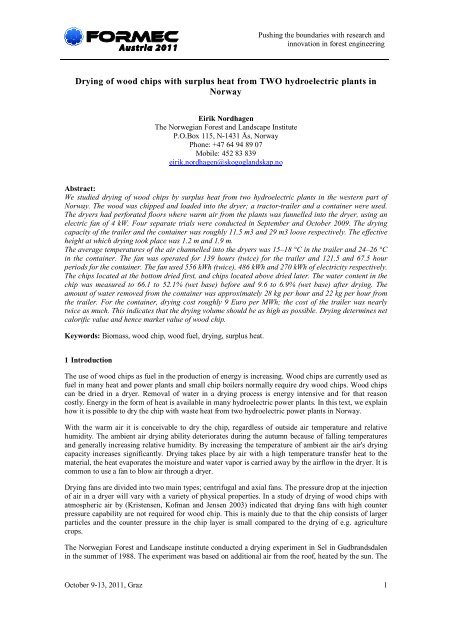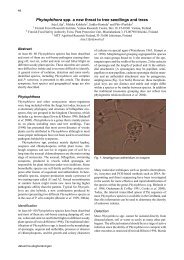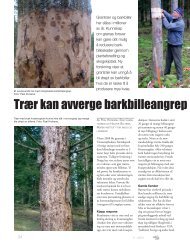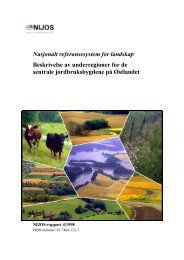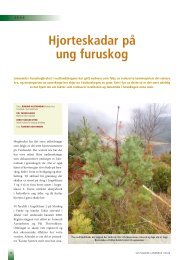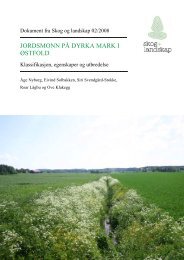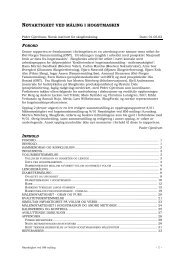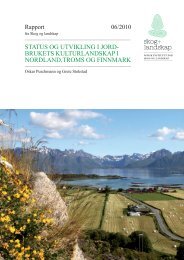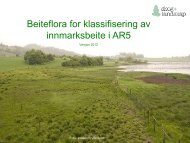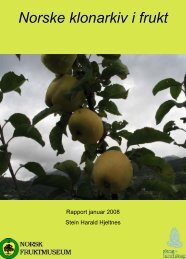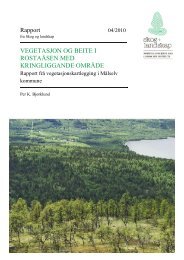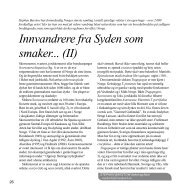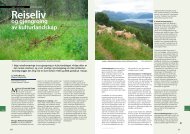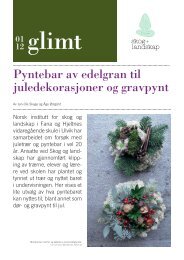Drying of wood chips with surplus heat from ... - Skog og landskap
Drying of wood chips with surplus heat from ... - Skog og landskap
Drying of wood chips with surplus heat from ... - Skog og landskap
You also want an ePaper? Increase the reach of your titles
YUMPU automatically turns print PDFs into web optimized ePapers that Google loves.
Pushing the boundaries <strong>with</strong> research and<br />
innovation in forest engineering<br />
<strong>Drying</strong> <strong>of</strong> <strong>wood</strong> <strong>chips</strong> <strong>with</strong> <strong>surplus</strong> <strong>heat</strong> <strong>from</strong> TWO hydroelectric plants in<br />
Norway<br />
Eirik Nordhagen<br />
The Norwegian Forest and Landscape Institute<br />
P.O.Box 115, N-1431 Ås, Norway<br />
Phone: +47 64 94 89 07<br />
Mobile: 452 83 839<br />
eirik.nordhagen@sk<strong>og</strong><strong>og</strong><strong>landskap</strong>.no<br />
Abstract:<br />
We studied drying <strong>of</strong> <strong>wood</strong> <strong>chips</strong> by <strong>surplus</strong> <strong>heat</strong> <strong>from</strong> two hydroelectric plants in the western part <strong>of</strong><br />
Norway. The <strong>wood</strong> was chipped and loaded into the dryer; a tractor-trailer and a container were used.<br />
The dryers had perforated floors where warm air <strong>from</strong> the plants was funnelled into the dryer, using an<br />
electric fan <strong>of</strong> 4 kW. Four separate trials were conducted in September and October 2009. The drying<br />
capacity <strong>of</strong> the trailer and the container was roughly 11.5 m3 and 29 m3 loose respectively. The effective<br />
height at which drying took place was 1.2 m and 1.9 m.<br />
The average temperatures <strong>of</strong> the air channelled into the dryers was 15–18 °C in the trailer and 24–26 °C<br />
in the container. The fan was operated for 139 hours (twice) for the trailer and 121.5 and 67.5 hour<br />
periods for the container. The fan used 556 kWh (twice), 486 kWh and 270 kWh <strong>of</strong> electricity respectively.<br />
The <strong>chips</strong> located at the bottom dried first, and <strong>chips</strong> located above dried later. The water content in the<br />
chip was measured to 66.1 to 52.1% (wet base) before and 9.6 to 6.9% (wet base) after drying. The<br />
amount <strong>of</strong> water removed <strong>from</strong> the container was approximately 28 kg per hour and 22 kg per hour <strong>from</strong><br />
the trailer. For the container, drying cost roughly 9 Euro per MWh; the cost <strong>of</strong> the trailer was nearly<br />
twice as much. This indicates that the drying volume should be as high as possible. <strong>Drying</strong> determines net<br />
calorific value and hence market value <strong>of</strong> <strong>wood</strong> chip.<br />
Keywords: Biomass, <strong>wood</strong> chip, <strong>wood</strong> fuel, drying, <strong>surplus</strong> <strong>heat</strong>.<br />
1 Introduction<br />
The use <strong>of</strong> <strong>wood</strong> <strong>chips</strong> as fuel in the production <strong>of</strong> energy is increasing. Wood <strong>chips</strong> are currently used as<br />
fuel in many <strong>heat</strong> and power plants and small chip boilers normally require dry <strong>wood</strong> <strong>chips</strong>. Wood <strong>chips</strong><br />
can be dried in a dryer. Removal <strong>of</strong> water in a drying process is energy intensive and for that reason<br />
costly. Energy in the form <strong>of</strong> <strong>heat</strong> is available in many hydroelectric power plants. In this text, we explain<br />
how it is possible to dry the chip <strong>with</strong> waste <strong>heat</strong> <strong>from</strong> two hydroelectric power plants in Norway.<br />
With the warm air it is conceivable to dry the chip, regardless <strong>of</strong> outside air temperature and relative<br />
humidity. The ambient air drying ability deteriorates during the autumn because <strong>of</strong> falling temperatures<br />
and generally increasing relative humidity. By increasing the temperature <strong>of</strong> ambient air the air's drying<br />
capacity increases significantly. <strong>Drying</strong> takes place by air <strong>with</strong> a high temperature transfer <strong>heat</strong> to the<br />
material, the <strong>heat</strong> evaporates the moisture and water vapor is carried away by the airflow in the dryer. It is<br />
common to use a fan to blow air through a dryer.<br />
<strong>Drying</strong> fans are divided into two main types; centrifugal and axial fans. The pressure drop at the injection<br />
<strong>of</strong> air in a dryer will vary <strong>with</strong> a variety <strong>of</strong> physical properties. In a study <strong>of</strong> drying <strong>of</strong> <strong>wood</strong> <strong>chips</strong> <strong>with</strong><br />
atmospheric air by (Kristensen, K<strong>of</strong>man and Jensen 2003) indicated that drying fans <strong>with</strong> high counter<br />
pressure capability are not required for <strong>wood</strong> chip. This is mainly due to that the chip consists <strong>of</strong> larger<br />
particles and the counter pressure in the chip layer is small compared to the drying <strong>of</strong> e.g. agriculture<br />
crops.<br />
The Norwegian Forest and Landscape institute conducted a drying experiment in Sel in Gudbrandsdalen<br />
in the summer <strong>of</strong> 1988. The experiment was based on additional air <strong>from</strong> the ro<strong>of</strong>, <strong>heat</strong>ed by the sun. The<br />
October 9-13, 2011, Graz 1
Pushing the boundaries <strong>with</strong> research and<br />
innovation in forest engineering<br />
results showed that solar <strong>heat</strong>ing provides better drying effects than an ordinary drying <strong>with</strong> ambient air<br />
(Grønlien, Fæste and Tengesdal 1991). In the drying experiment the drying time was five days and the<br />
collector system increased the temperature <strong>of</strong> the drying air by 5 °C. At the end <strong>of</strong> the trial the mean<br />
water content in the chip was 13.4% (wet base).<br />
Energy in the form <strong>of</strong> <strong>heat</strong> is available <strong>from</strong> process industry, incinerators and power plants. In electric<br />
power plants mechanical energy is transformed into electrical energy. The efficiency <strong>of</strong> the generator is<br />
up to 98-99% (Novakovic, 2000). This means that in a hydropower plant 1-2% <strong>of</strong> the energy produced is<br />
<strong>heat</strong>. It is reasonable to dry energy <strong>wood</strong> at the storage site using natural forces such as solar and wind<br />
energy. However, the weather or climate can limit the drying <strong>of</strong> energy <strong>wood</strong> outdoors. The objective <strong>of</strong><br />
this study was to find out if excess <strong>heat</strong> <strong>from</strong> electric power plants can be used for drying <strong>of</strong> <strong>wood</strong> <strong>chips</strong><br />
and in seasons that are normally not very favorable for drying in atmospheric air. In addition it was also<br />
interesting to calculate the energy used and gained by drying the chip as well as the costs in euro per<br />
MWh.<br />
2 Material and Methods<br />
The fieldwork for this study took place at Kleive and Viksdalen in Norway. We dried <strong>wood</strong> <strong>chips</strong> in the<br />
immediate vicinity <strong>of</strong> two small hydropower stations as shown in Figure 1. Installed capacity was 2.2<br />
MW and 1 MW respectively. The four drying experiments took place in late September and October. The<br />
dryers had perforated floors <strong>of</strong> steel <strong>with</strong> 3 mm holes. The <strong>heat</strong> <strong>from</strong> the power plant was distributed in<br />
the space below the steel plate.<br />
The container was a standard GMM hook container <strong>with</strong> movable ro<strong>of</strong> cover, and a side door for<br />
connecting the air duct. After rebuilding the container it was 6.0 m long, 2.4 m wide and 1.92 m high. The<br />
total volume was then 27.65 m 3 . The tractor trailer was an Orkel TT 100 <strong>with</strong> scrollable canvas <strong>with</strong><br />
ridge. After the rebuilding the trailer was 4.0 m long, 2.4 m wide and 1.2 m high. The total volume was<br />
11.52 m 3 .<br />
Figure 1: The hydroelectric power plants and the container (left) and trailer (right).<br />
The radial fan, a Kongskilde HVL 55, had a power output <strong>of</strong> 4 kW. The fan should in accordance <strong>with</strong> the<br />
manufacturer provide large air flow and fan performance varies minimally by changes in pressure <strong>from</strong><br />
various materials. The fan should be suitable for bed drying up to 5-6 meters.<br />
October 9-13, 2011, Graz 2
2.1 Measurements<br />
Pushing the boundaries <strong>with</strong> research and<br />
innovation in forest engineering<br />
In order to weigh the chip loads the trailer and the container where placed on the weighing platforms <strong>of</strong><br />
the type WWSE10T. The drying air temperature, relative humidity and the ambient temperature where<br />
registered every half hour. Moisture content samples were taken <strong>from</strong> the chip before and after drying.<br />
Electricity used by the electric fan was measured.<br />
3 Results and discussions<br />
3.1 Temperature and relative humidity<br />
The air temperature at the top and bottom <strong>of</strong> the dryer and the ambient temperature are shown in Figure 2.<br />
The energy in the drying air is used to evaporate the water and the temperature drops. When the moisture<br />
content is low the temperature rises. The temperature rises first at the bottom <strong>of</strong> the chip load, and later at<br />
the top <strong>of</strong> the stack. The drying zone moves in other words, through the chip layer in the dryer. The<br />
dotted red line shows the ambient air temperature.<br />
Measurements at the end <strong>of</strong> the drying process showed that the temperature and relative humidity in the<br />
dryer was about the same as in the drying channel. The explanation is probably that there is little water to<br />
evaporate. To control this, one sensor was placed in the drying channel. The temperature in the channel<br />
was approximately the same as in the chip layer. This can be seen before and after the drop in the red line<br />
in Figure 2.<br />
Figure 2: The air temperature at the bottom and top <strong>of</strong> the container and outside the container.<br />
The figures in Table 1 shows that the air <strong>from</strong> the power plant contributed to an increase <strong>of</strong> the<br />
temperature <strong>of</strong> the air and the temperature was higher in Istad power station (container) than in Vallestad<br />
power station (trailer). The mean average values in Table 1 are based on collected records every half an<br />
hour.<br />
October 9-13, 2011, Graz 3
Table 1: Mean values for air temperature and relative humidity<br />
Temperature Relative<br />
humidity<br />
Pushing the boundaries <strong>with</strong> research and<br />
innovation in forest engineering<br />
Site Dryer (°C) Outside (°C) Dryer (%) Outside (%)<br />
Container 26.0<br />
Trailer<br />
24.4<br />
14.9<br />
18.5<br />
3.2 Energy consumption and energy costs<br />
11.0<br />
1.8<br />
5.9<br />
8.4<br />
The consumption <strong>of</strong> electricity for the radial fan was measured and the effect was 4 kW, which means<br />
maximum effect. The electricity costs were set to 5 euro cents per kWh. Energy costs varied according to<br />
fan hours i.e. drying time (Table 2).<br />
October 9-13, 2011, Graz 4<br />
26.3<br />
23.7<br />
43.8<br />
29.9<br />
87.6<br />
90.7<br />
95.8<br />
64.3<br />
Table 2: Effect fan, fan hours, energy used, energy prices and costs.<br />
Site<br />
Container 4<br />
Effect fan<br />
(kW)<br />
4<br />
Trailer 4<br />
3.3 Weight and moisture content<br />
4<br />
Fan hours<br />
(h)<br />
121.5<br />
67.5<br />
139<br />
139<br />
Energy used<br />
(kWh)<br />
486<br />
270<br />
Energy price<br />
(¢ per kWh)<br />
Three samples for the moisture content (wet base) were collected <strong>from</strong> the chip before and after drying.<br />
After drying, one sample was collected <strong>from</strong> the bottom, middle and top layer and they were collected<br />
near the rim <strong>of</strong> the container and trailer. The container and trailer were placed on load cells and the<br />
weights were recorded continuously over time (Table 3). The amount <strong>of</strong> water lost <strong>from</strong> the container was<br />
approximately 28 kg per hour and <strong>from</strong> the trailer 22 kg per hour.<br />
556<br />
556<br />
5<br />
5<br />
5<br />
5<br />
Costs<br />
(€)<br />
24.3<br />
13.5<br />
27.8<br />
27.8
Pushing the boundaries <strong>with</strong> research and<br />
innovation in forest engineering<br />
Table 3: Chip weight and measured moisture content before and after drying.<br />
Site<br />
Container<br />
Trailer<br />
Before drying After drying<br />
Chip weight<br />
(kg)<br />
7485<br />
7045<br />
5300<br />
5165<br />
Moisture content<br />
(%)<br />
52,7<br />
52,3<br />
66,1<br />
61,0<br />
3.4 Net calorific value before and after drying<br />
Chip weight<br />
October 9-13, 2011, Graz 5<br />
(kg)<br />
4010<br />
4935<br />
Moisture content<br />
We calculated the net calorific value <strong>of</strong> the chip load before and after drying. Typical values for net<br />
calorific value <strong>of</strong> solid biomass fuels are 19.1 MJ/kg or 5.3 kWh/kg <strong>of</strong> dry mass (EN 14961-1:2010). The<br />
net calorific value as received (the moist bi<strong>of</strong>uels) can be calculated <strong>from</strong> the net calorific value <strong>of</strong> the dry<br />
basis (EN 14961-1:2010). The moisture samples were taken in front <strong>of</strong> the container. It is unlikely that<br />
<strong>wood</strong> <strong>chips</strong> in the middle <strong>of</strong> the container were as dry as shown in table 3. We therefore used an<br />
estimated value <strong>of</strong> 11% moisture content in the calculation <strong>of</strong> calorific value for the <strong>wood</strong> chip in the<br />
container. Calculated mean net calorific value before and after drying and the difference are shown in<br />
Table 4.<br />
2185<br />
2165<br />
(%)<br />
-<br />
6,9<br />
9,6<br />
8,7<br />
Table 4: Mean net calorific value before and after drying<br />
Site<br />
3.5 The costs <strong>of</strong> drying <strong>wood</strong> chip<br />
Before drying After drying Increase<br />
Calorific value<br />
(MWh)<br />
Calorific value<br />
(MWh)<br />
Container 15.9 18.4 2.5<br />
Trailer 7.7 10.2 2.5<br />
Calorific value<br />
(MWh)<br />
The hourly rate for transport and handling is set to 77 € per hour. The tractor driver used approximately 2<br />
hours for transport and handling. The drying costs in euro per MWh <strong>of</strong> the trailer were almost twice as<br />
much as the container. This indicates that the drying volume must be as high as possible. As shown in<br />
Table 5, the drying costs can be a considerable cost factor in the supply chain. Total costs do not include<br />
investment costs for the dryer.
4 Conclusion<br />
Site<br />
Table 5: Mean costs and calorific value <strong>of</strong> drying <strong>wood</strong> chip<br />
Energy costs<br />
(€)<br />
Transport costs<br />
(€)<br />
Pushing the boundaries <strong>with</strong> research and<br />
innovation in forest engineering<br />
Calorific value<br />
(MWh)<br />
Container 24.3 153 18.4 9.6<br />
October 9-13, 2011, Graz 6<br />
Costs<br />
Trailer 27.8 153 10.2 17.7<br />
(€ per MWh)<br />
This study concludes that <strong>heat</strong> <strong>from</strong> hydroelectric power plants can be used for drying <strong>of</strong> <strong>wood</strong> <strong>chips</strong> and<br />
in seasons that are normally not very favorable for drying in atmospheric air. It took less time to dry the<br />
<strong>wood</strong> <strong>chips</strong> <strong>with</strong> warm air than <strong>with</strong> ambient air. According to (Gigler et al. 2000) drying times varied<br />
<strong>from</strong> 21 to 100 days <strong>with</strong> ambient drying air. This study showed that one can dry a container and a tractor<br />
trailer <strong>with</strong> <strong>wood</strong> <strong>chips</strong> in approximately 6 days and it was possible to dry the <strong>wood</strong> <strong>chips</strong> down to about<br />
10% water content.<br />
A tractor trailer and a container can easily be converted to a dryer for <strong>wood</strong> <strong>chips</strong>. Other buildings, <strong>with</strong><br />
waste <strong>heat</strong> can probably also be used as a <strong>heat</strong>ing source for drying <strong>of</strong> <strong>wood</strong> <strong>chips</strong>. The cost <strong>of</strong> drying<br />
must be considered in a supply chain for <strong>wood</strong> <strong>chips</strong>. Dried <strong>wood</strong> <strong>chips</strong> can be stored <strong>with</strong>out loss <strong>of</strong> dry<br />
matter. It is possible to blend dried <strong>wood</strong> <strong>chips</strong> <strong>with</strong> moister <strong>wood</strong> <strong>chips</strong>. <strong>Drying</strong> determines net calorific<br />
value and hence market value <strong>of</strong> <strong>wood</strong> chip.<br />
5 References<br />
EN 14961-1. Solid bi<strong>of</strong>uels - Fuel specifications and classes - Part 1: General requirements,<br />
http://www.cen.eu/cen/pages/default.aspx; 2010.<br />
Gigler, J. K., W. K. P. van Loon, M. M. Vissers & G. P. A. Bot (2000) Forced convective drying <strong>of</strong><br />
willow <strong>chips</strong>. Biomass and Bioenergy, 19, 259-270.<br />
Grønlien, H. H., I. Fæste & G. Tengesdal. 1991. Tørking av brenselflis i universaltørke med solfanger.<br />
Ås: <strong>Sk<strong>og</strong></strong>forsk.<br />
Kristensen, E. F., P. D. K<strong>of</strong>man & P. D. Jensen (2003) Counter pressure on ventilation <strong>of</strong> different types<br />
<strong>of</strong> <strong>wood</strong> chip and chunk<strong>wood</strong>. Biomass and Bioenergy, 25, 399-408.<br />
Novakovic, V. (2000) Energi i Norge. Ressurser, teknol<strong>og</strong>i <strong>og</strong> miljø. SINTEF rapport TR A5171.


